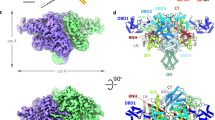Summary
Tn951 is flanked by two perfect inverted repeats of 41 bp which include the 38 bp sequence of the IR of Tn3. Tn951 also contains the last 100 bp of the tnpA gene but with at least two mutations. However, beyond nucleotide 137 the sequences diverge and hybridization experiments show that Tn951 lacks at least the first two thirds of the tnpA gene.
In agreement with these observations Tn951 does not transpose by itself at a detectable frequency but can be complemented by the tnpA gene of Tn801 or Tn3. Tn501, Tn1721 and gamma delta do not complement Tn951 transposition.
Transposition of Tn951 duplicates 5 bp of target DNA sequence.
Similar content being viewed by others
References
Arthur A, Sherratt D (1979) Dissection of the transposition process: a transposon-encoded site-specific recombination system. Mol Gen Genet 175:267–274
Bachmann BJ (1972) Pedigrees of some mutant strains of Escherichia coli K12. Bacteriol Rev 36:525–557
Bagdasarian M, Bagdasarian MM, Coleman S, Timmis KN (1979) New vector plasmids for gene cloning in Pseudomonas. In: Timmis KN, Pühler A (eds) Plasmids of medical, environmental and commercial importance. Elsevier North-Holland Biomedical Press, Amsterdam, pp 411–422
Bennett PM, Grinsted J, Choi CL, Richmond MH (1978) Characterization of Tn501, a transposon determining resistance to mercuric ions. Mol Gen Genet 159:101–106
Calos MP, Miller JH (1980) Transposable elements. Cell 20:579–595
Chou J, Lemaux PG, Casadaban MJ, Cohen SN (1979) Transposition protein of Tn3: identification and characterization of an essential repressor-controlled gene product. Nature 282:801–806
Chou J, Casadaban MJ, Lemaux PG, Cohen SN (1979) Identification and characterization of a self-regulated repressor of translocation of the Tn3 element. Proc Natl Acad Sci USA 76:4020–4024
Cornelis G (1980) Transposition of Tn951 (TnLac) and cointegrate formation are thermosensitive processes. J Gen Microbiol 117:243–247
Cornelis G (1981) Sequence relationships between plasmids carrying genes for lactose utilization. J Gen Microbiol 124:91–97
Cornelis G, Bennett PM, Grinsted J (1976) Properties of pGC1, a Lac plasmid originating in Yersinia enterocolitica 842. J Bacteriol 127:1058–1062
Cornelis G, Ghosal D, Saedler H (1978) Tn951: a new transposon carrying a lactose operon. Mol Gen Genet 160:215–224
Cornelis G, Ghosal D, Saedler H (1979) Multiple integration sites for the lactose transposon Tn951 on plasmid RP1 and establishment of a coordinate system for Tn951. Mol Gen Genet 168:61–67
Cornelis G, Meier U, Hoeksma G, Ghosal D, Cullum J, Saedler H (1980) The lactose transposon Tn951: characterization of transposition. Ann Microbiol (Institut Pasteur) 131A:233–247
Cornelis G, Saedler H (1980) Deletions and an inversion induced by a resident IS1 of the lactose transposon Tn951. Mol Gen Genet 178:367–374
de Graaf J, Crosa JH, Heffron F, Falkow S (1978) Replication of the non-conjugative plasmid RSF1010 in Escherichia coli K12. J Bacteriol 134:1117–1122
Gill RE, Heffron F, Falkow S (1979) Identification of the protein encoded by the transposable element Tn3 which is required for its transposition. Nature 282:797–801
Grinsted J, Bennett PM, Higginson S, Richmond MH (1978) Regional preference of insertion of Tn501 and Tn802 into RP1 and its derivatives. Mol Gen Genet 166:313–320
Guyer M (1978) The γδ sequence of F is an insertion sequence. J Mol Biol 126:347–365
Heffron F, McCarty B, Ohtsubo H, Ohtsubo E (1979) DNA sequence analysis of the transposon Tn3: three genes and three sites involved in transposition of Tn3. Cell 18:1153–1163
Heffron F, Rubens C, Falkow S (1975) Translocation of a plasmid DNA sequence which mediates ampicillin resistance: molecular nature and specificity of insertion. Proc Natl Acad Sci USA 72:3623–3627
Kretschmer PJ, Cohen SN (1977) Selected translocation of plasmid genes: frequency and regional specificity of translocation of the Tn3 element. J Bacteriol 130:888–899
Maxam AM, Gilbert W (1980) Sequencing end-labeled DNA with base-specific chemical cleavages. In: Grossman L, Moldave K (eds) Methods in enzymology, vol 65. Academic Press, New York, pp 499–559
Meacock PA, Cohen SN (1979) Genetic analysis of the interrelationship between plasmid replication and incompatibility. Mol Gen Genet 174:135–147
Miller C, Cohen SN (1980) F plasmid provides a function that promotes recA-independent site-specific fusions of pSC101 replicon. Nature 285:577–579
Ohtsubo H, Ohmori H, Ohtsubo E (1979) Nucleotide sequence analysis of the ampicillin resistance transposon Tn3: implication for insertion and deletion. Cold Spring Harbor Symp Quant Biol 43:1269–1277
Ohtsubo E, Zenilman M, Ohtsubo H (1980) Plasmids containing insertion elements are potential transposons. Proc Natl Acad Sci USA 77:750–754
Reed RR, Young RA, Steitz JA, Grindley NDF, Guyer M (1979) Transposition of the Escherichia coli insertion element γδ generates a five-base-pair repeat. Proc Natl Acad Sc USA 76:4882–4886
Robinson MK, Bennett PM, Falkow S, Dodd HM (1980) Isolation of a temperature-sensitive derivative of RP1. Plasmid 3:343–347
Rubens C, Heffron F, Falkow S (1976) Transposition of a plasmid deoxyribonucleic acid sequence that mediates ampicillin resistance: independence from host rec functions and orientation of insertion. J Bacteriol 128:425–434
Schöffl F, Arnold W, Pühler A, Altenbuchner J, Schmitt R (1981) The tetracycline resistance transposons Tn1721 and Tn1771 have three 38-base-pair repeats and generate five-base-pair direct repeats. Mol Gen Genet 181:87–94
Sharp PA, Hsu MT, Ohtsubo E, Davidson N (1972) Electron microscope heteroduplex studies of sequence relations among plasmids of Escherichia coli. I Structure of F-prime factors. J Mol Biol 71:471–497
Willetts N (1975) Recombination and the E. coli K12 sex factor. J Bacteriol 121:36–43
Author information
Authors and Affiliations
Additional information
Communicated by E. Bautz
Rights and permissions
About this article
Cite this article
Cornelis, G., Sommer, H. & Saedler, H. Transposon Tn951 (TnLac) is defective and related to Tn3. Molec. Gen. Genet. 184, 241–248 (1981). https://doi.org/10.1007/BF00272911
Received:
Issue Date:
DOI: https://doi.org/10.1007/BF00272911




